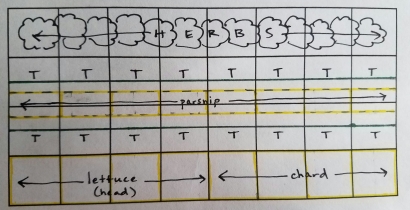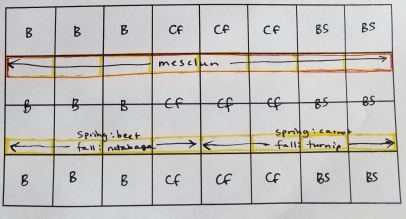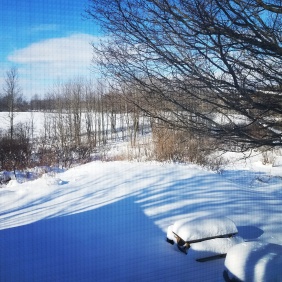Every year we get to the first planting day of the season and I wonder where the time has gone. Just a few years ago, around this same time, we were planting a hodgepodge of things in plastic cups for our tiny balcony garden. Now we’re starting our second season at our farm property and we’re gearing up to grow many of our daughter’s first solid foods. Time flies too fast, but it feels good to be so connected to the changing seasons.

If you had the chance to look at our small garden plans for this year, you’ll notice that almost everything can be directly sown in place. The only exceptions are nightshade crops, like tomatoes and peppers. In typical seasons we start spring brassicas (like broccoli and kale) indoors, but I’ll just be direct sowing them to save space inside. We also usually grow eggplant, but because space is limited in the garden and we don’t get comparable yields we’ve decided to purchase these from other farms this year. We’ll just be growing tomatoes, peppers, and tomatillos for transplanting.
My rule of thumb is to seed roughly an extra 33% of each transplanted. For example, if I’m planning on planting tomatoes in the field, I’ll start by multiplying six by 1.33. This equals 7.98, so I’ll seed eight paste tomatoes. This accounts for any seeds that may not germinate and allows us to choose the best plants. (I could sell the extra plants, but usually I just bring them to my parents for their “empty nester” garden. It saves them some hassle, and they get a much wider variety than what they’d find at the nursery!)
So with that in mind, here’s what we’re sowing indoors today:

And I will also note that I usually grow in soil blocks, but because I’m seeding so few transplants I’ve decided to keep the equipment clean, save myself some time, and just grow in plug flats such as these. I’m keeping the mix the same, which is based on Eliot Coleman’s soil block formula, as it has yielded strong results in the past:
- 3 quarts compost (I use my father-in-law’s homemade vermicompost)
- 3 quarts coconut coir
- 1 quart vermiculite
- 6 tbsp fertilizer (such as this blend)
I can’t wait to see those little sprouts over the next few weeks. Hopefully it’ll hold me off until warmer spring weather arrives.
Happy planting!








 Based on common biointensive spacing recommendations I’ve made some hexagonal pattern templates. Using unfolded paper napkins or paper towels, which are just about a square foot in size, put dots of the paste or glue in the appropriate spots and then place your seeds. You’ll still have to thin your beets, but that’s a lot less work than thinning all of your roots and greens! I’m thinking this will make our succession planting pretty easy when the time comes, as I’ll just have to place another napkin down, cover as needed with compost, and move on.
Based on common biointensive spacing recommendations I’ve made some hexagonal pattern templates. Using unfolded paper napkins or paper towels, which are just about a square foot in size, put dots of the paste or glue in the appropriate spots and then place your seeds. You’ll still have to thin your beets, but that’s a lot less work than thinning all of your roots and greens! I’m thinking this will make our succession planting pretty easy when the time comes, as I’ll just have to place another napkin down, cover as needed with compost, and move on. Good morning! How great is it to wake up to sunshine and blue skies? Winters here are mostly grey (plus we’re in zone 5 and it’s super cold), so this weather makes for an instant good mood. We won’t be straying far from the house today but it’ll give us the chance to catch up on some chores and cooking. And I’m trying to buckle down on plans for this year’s vegetable garden.
Good morning! How great is it to wake up to sunshine and blue skies? Winters here are mostly grey (plus we’re in zone 5 and it’s super cold), so this weather makes for an instant good mood. We won’t be straying far from the house today but it’ll give us the chance to catch up on some chores and cooking. And I’m trying to buckle down on plans for this year’s vegetable garden.